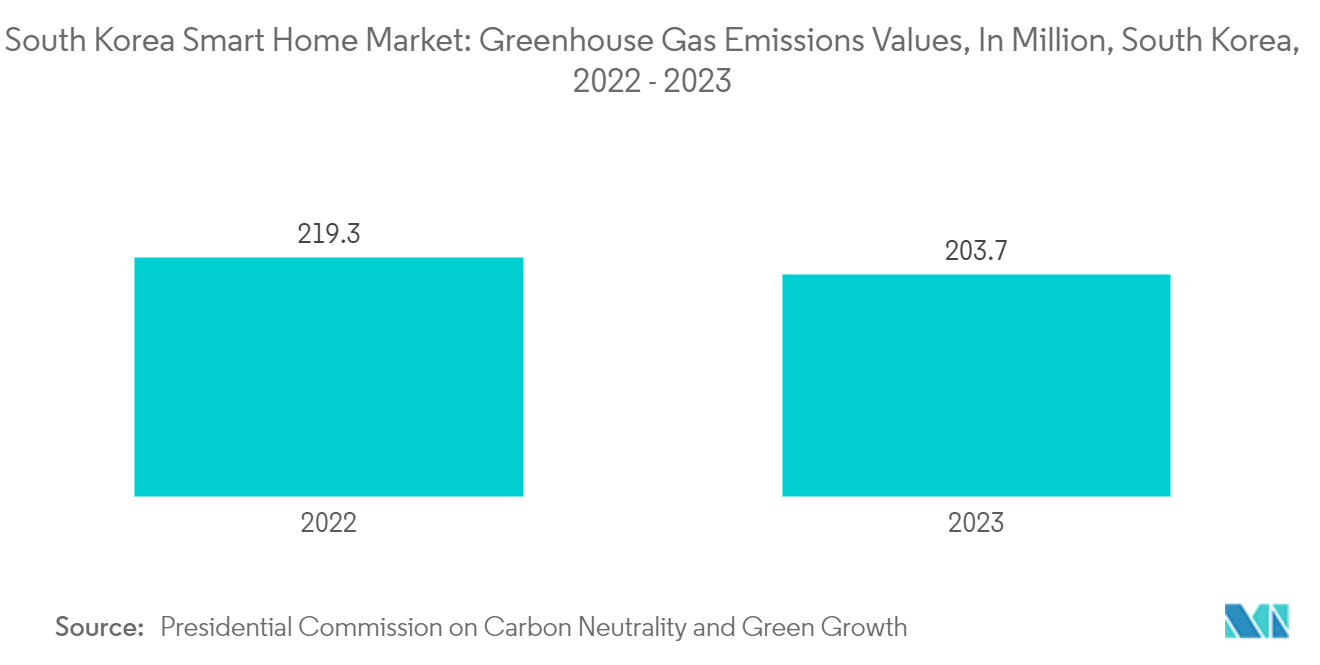Market Trends of South Korea Smart Home Industry
Rising Focus Toward Energy Efficiency is Driving the Market
- South Korea actively pushes its energy transition toward cleaner and safer sources. This shift involves reducing reliance on coal and nuclear energy while ramping up the adoption of renewables. On the demand side, the focus is on developing energy-efficient electronic products. Since the Energy Use Rationalization Act of 1979, South Korea has consistently rolled out energy demand management policies.
- Despite these efforts, South Korea's energy efficiency metrics paint a concerning picture. The nation is one of the highest energy consumers per capita globally, but its energy intensity only ranks 33rd among OECD member states.
- Recognizing the urgency of revamping its consumption patterns, South Korea unveiled the National Plan for Energy Efficiency Innovation. This plan mirrors the strategies advocated by the International Energy Agency (IEA): leveraging incentives to boost private investments, employing market-based tools for innovation, and emphasizing robust data collection.
- In a significant move in June 2023, South Korea inked a pact with 30 major energy-consuming corporations, offering tax breaks, financial rewards, and enhanced policy support to those championing energy conservation.
- These initiatives underscore South Korea's commitment to energy efficiency and open lucrative avenues, especially in the burgeoning smart home market. Smart home technologies, such as advanced HVAC systems, can dynamically adjust heating or cooling based on residents' presence, curbing energy wastage in unoccupied spaces.

Comfort and Lighting to Witness Significant Growth
- With growing concerns regarding targets of reducing carbon emissions, many property owners are embracing sustainability by transitioning to LED lighting in their residential communities. With extensive lighting networks that operate 24/7, these properties are finding significant energy savings by switching to smart LED solutions. Consequently, renters and homeowners are following suit, opting for a diverse range of smart LED options for their interior lighting.
- The journey of smart lighting in South Korea has been remarkable. The advent of LED technology marked a pivotal moment, revolutionizing the lighting landscape. For instance, in March 2024, Gocheok Sky Dome, Seoul's exclusive domed baseball park in the western part of the city, received a significant facelift in preparation for the momentous Major League Baseball (MLB) season-opening series. The Seoul government disclosed that the stadium now boasts a fresh 11,493 square meter (2.8 acres) artificial grass surface, a first of its kind in the nation. Also, the lighting system has been upgraded to brighter, more energy-efficient LED lights, effectively replacing the previous metal halide lamps. Notably, the venue has also added 56 vibrant-colored LED lamps to enhance the ambiance for the event.
- With their enhanced energy efficiency, durability, and extended lifespan, LEDs outshine traditional bulbs. A key trend in smart homes is the surge of intelligent lighting and home automation. Consumers now seek lighting solutions that can be controlled remotely via smartphones, voice assistants, or integrated smart home systems, offering convenience and installation flexibility.
- Korea's LED industry lagged behind Japan and Taiwan in its inception, aligning more closely with China's timeline. Yet, Korea swiftly outpaced its counterparts in advancements. Despite this, the Korean LED sector faced a steeper decline compared to Japan, China, and Taiwan. The industry's evolution unfolded in distinct phases: first, led by upstream manufacturers in what was dubbed the "double E era," then marked by the entries of tech giants Samsung and LG during the Solid State Lighting (SSL) peak, and finally, a notable retreat as a response to China's burgeoning LED sector.
- URC made waves in June 2023 by unveiling its URC Lighting LT-3300, a versatile lighting solution. This innovation empowers installers to choose between dimmers or switches, enabling easy programming for tailored atmospheres for lively gatherings or serene family moments. Noteworthy features include auto load detection and streamlining installations by eliminating the need for specific configurations unless used as an accessory.
- Also, Korea's spotlight has shifted toward OLEDs and quantum dots. The nation leverages its robust electronic export market and a well-established supply chain. Yet, despite these strengths, Korea's product portfolio often needs the spark of true innovation.


